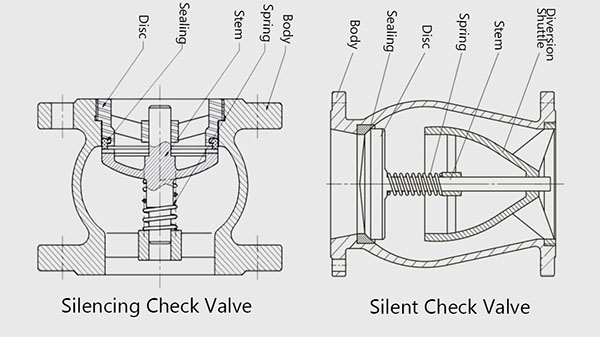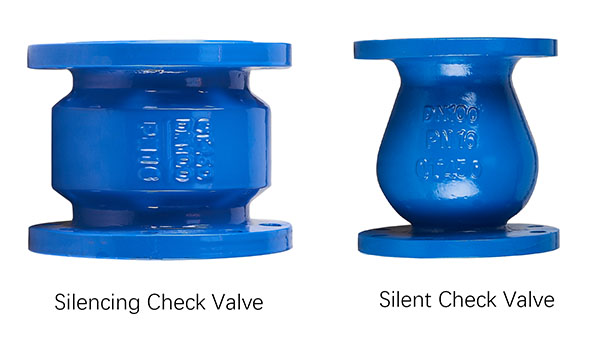The difference between silencing check valves and silent check valves mainly depends on the level of silencing. Silencing check valve only eliminate noise and reduce noise. Silent check valve can directly shield and silence the sound when used.
Silent check valves are mainly used on water system pipelines and are installed at the outlet of the water pump. It is composed of valve body, valve disc, valve stem, spring and other parts. The closing stroke is short and the reverse flow speed is small at the moment of closing. The valve disc seal adopts rubber soft seal, and the spring return makes the valve open and close without impact, reducing noise and water hammer effect, so it is called a silencer check valve. Its valve core adopts a lifting structure and is a type of lifting check valve.
Silencing check valves are mainly installed vertically. For double-sided guide valve cores, they can also be installed horizontally. However, for large-diameter valves, the self-weight of the valve disc is relatively large, which will cause unilateral wear on the guide sleeve, and in severe cases affect the sealing effect. Therefore, it is recommended to install vertically for large-diameter valves.
The silent check valve also named axial flow check valve, it is a key device installed at the outlet of a pump or compressor to prevent medium backflow. Because the axial flow check valve has the characteristics of strong flow capacity, small flow resistance, good flow pattern, reliable sealing and no water hammer when opening and closing. It is installed at the water inlet of the water pump and can be quickly closed before the water flow reverses. , to avoid water hammer, water hammer sound and devastating impact to achieve a silent effect. Therefore, it has been widely used in oil and gas long-distance pipelines, nuclear power plant main water supply, compressors and large pumps in large ethylene plants, etc. .
It is mainly composed of valve body, valve seat, valve disc, spring, guide rod, guide sleeve, guide cover and other parts. The inner surface of the valve body, the guide cover, the valve disc and other flow-passing surfaces should be streamlined to meet the hydraulic shape design, and should be rounded in the front and pointed in the back to obtain a better streamlined waterway. The fluid behaves primarily as laminar flow at its surface, with little or no turbulence. The inner cavity of the valve body is a Venturi structure. When the fluid flows through the valve channel, it gradually shrinks and expands, minimizing the generation of eddy currents. The pressure loss is small, the flow pattern is stable, no cavitation, and low noise.
Can be installed horizontally and vertically. When a large diameter is installed horizontally, the guide rod should adopt a double guide structure to avoid excessive wear on one side of the guide sleeve and guide rod caused by the weight of the valve disc. This causes the valve disc sealing effect to decrease and the noise to increase when closing.

The difference between the Silencing check valves and Silent check valves:
1. The valve structure is different. The structure of the silencer check valve is relatively simple, and the flow channel check valve has a conventional structure. The structure of the axial flow check valve is slightly more complex. The inner cavity of the valve body is a Venturi structure with a flow guide inside. The entire flow surface is streamlined. The smooth transition of the flow channel reduces eddy currents and effectively reduces flow resistance.
2. The valve core sealing structure is different. The silencer check valve adopts a rubber soft-sealed valve core, and the entire valve core is covered with rubber, or the valve seat is sealed with a rubber ring. Axial flow check valves can use metal hard seals and hard alloy surfacing, or soft and hard composite sealing structures. The sealing surface is more durable and extends the service life.
3. Applicable working conditions are different. Silent check valves are mainly used in normal temperature pipelines such as water systems, with nominal pressures PN10--PN25 and diameters DN25-DN500. Materials include cast iron, cast steel, and stainless steel. Axial flow check valves are used in a wider range of applications, from liquefied natural gas at a low temperature of -161°C to high-temperature steam. Nominal pressure PN16-PN250, American standard Class150-Class1500. Diameter DN25-DN2000.

